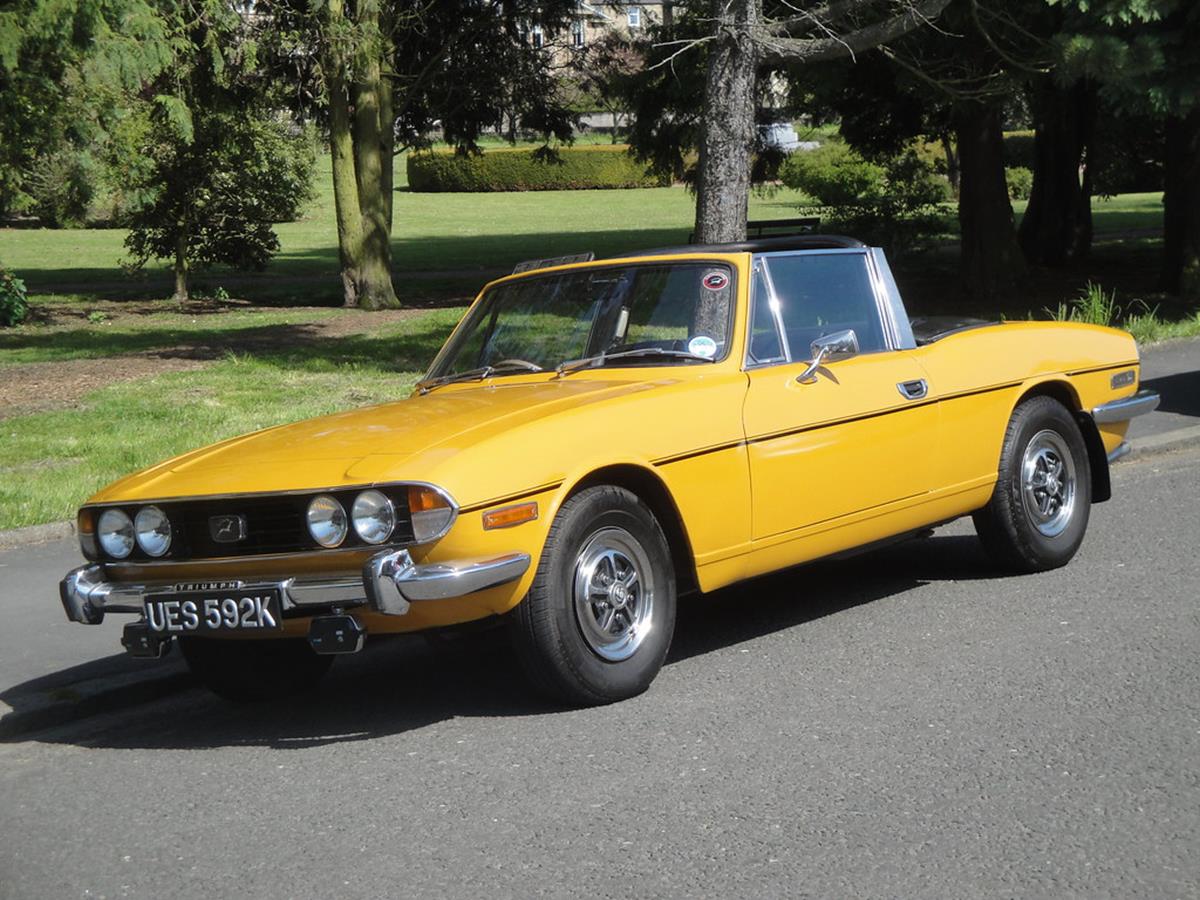
The Triumph Stag is a 2+2 sports tourer sold between 1970 and 1978 by the British Triumph Motor Company, styled by Italian designer Giovanni Michelotti.
Envisioned as a luxury sports car, the Stag was designed to compete directly with the Mercedes-Benz SL class models. All Stags were four-seater convertible coupés, but for structural rigidity – and to meet proposed American rollover standards of the time – the Stag required a B-pillar "roll bar" hoop connected to the windscreen frame by a T-bar. A body color removable hard top with defrost wires on the rear window, full headliner and lever operated quarter windows was a popular factory option for the early Stags, and was later supplied as a standard fitment.
The car started as a styling experiment cut and shaped from a 1963–64 pre-production 2000 saloon, also styled by Giovanni Michelotti. His agreement was, if Harry Webster, Director of Engineering at Triumph, liked the design, Triumph could use the prototype as the basis of a new model. Webster loved the design and took the prototype back to England. The end result, a two-door drop head (convertible), had little in common with the styling of its progenitor 2000, but retained the suspension and drive line. Triumph liked the Michelotti design so much that they propagated the styling lines of the Stag into the new T2000/T2500 saloon and estate model lines of the 1970s.[citation needed]
Triumph gave new projects four letter development code names (e.g. Bomb for Spitfire) and interestingly, Stag was the only Triumph to take its development code name into production.
Engineering
1972 Stag
The initial Stag design was based around the saloon's 2.5-litre six cylinder engine, but Webster intended the Stag, large saloons and estate cars to use a new Triumph-designed overhead cam (OHC) 2.5-litre fuel injected (PI) V8. In 1968, under the direction of Webster's successor, Spen King, the new 2.5 PI V8 was enlarged to 2,997 cc (3 L; 183 cu in) to increase torque. To meet emission standards in the US, a key target market, the troublesome mechanical fuel injection was dropped in favour of dual Zenith-Stromberg 175 CDSE carburettors. In common with several other manufacturers,[3] a key aim of Triumph's engineering strategy at the time was to create a family of in-line and V engines of different size around a common crankshaft. The various configurations Triumph envisaged would enable the production of four-, six-, and eight-cylinder power plants of capacity between 1.5 and 4 litres, sharing many parts, and hence offering economies of manufacturing scale and of mechanic training. A number of iterations of Triumph's design went into production, notably a 2.0-litre slant four-cylinder engine used in the later Dolomite and TR7, and a variant manufactured by StanPart that was initially used in the Saab 99. The Stag's V8 was the first of these engines to be fitted to a production car. Sometimes described as two four-cylinder engines siamesed together, it is more strictly correct to say the later four-cylinder versions were the left half of a Stag engine.
It has sometimes been alleged Triumph were instructed to use the proven all-aluminium Rover V8, originally designed by Buick, but claimed it would not fit. It is unclear if Triumph meant the Rover engine would not physically fit inside a Stag's engine bay. It can in fact be made to fit the space, but the decision to go with the Triumph V8 was probably driven more by the fact that the Buick's different torque characteristics and physical weight would have entailed substantial re-engineering of the Stag when it was almost ready to go on sale. Such a substitution would also have required a rethinking of the wider engineering strategy, both of which were important "fit" considerations beyond the comparatively trivial matter of the relative dimensions of the two engines. Furthermore, Rover, also owned by British Leyland, could not necessarily have supplied the numbers of V8 engines required to match the anticipated production of the Stag anyway.[4]
As in the 2000 model line, unitary construction was employed, as was fully independent suspension – MacPherson struts in front, semi-trailing arms at the rear. Braking was by front disc and rear drum brakes, while steering was power-assisted rack and pinion.

Production
1975 Triumph Stag
1977 Triumph Stag Mark 2
The car was launched one year late in 1970, to a warm welcome at the various international auto shows. The Stag rapidly acquired a reputation for mechanical unreliability, usually in the form of overheating. These problems arose from a variety of causes.
First, the late changes to the engine gave rise to design features that were questionable from an engineering perspective. For example, the water pump was set higher on the engine than is usual. If the engine became hot in traffic, and coolant escaped from the cooling system via the expansion bottle, the reduced volume of fluid left when the engine cooled down again fell below the level of the pump, which would eventually fail as a result. Water pump failures sometimes occurred due to poorly-hardened drive gears, which wore out prematurely and stopped the water pump.
A second cause of engine trouble was the lack of attention to corrosion inhibitor in the coolant. The block was made from iron and the heads from aluminium, a combination that required the use of corrosion-inhibiting antifreeze all year round. This point was not widely appreciated by owners or by the dealer network supporting them. Consequently, engines were affected by electrolytic corrosion and white alloy oxide sludge collected in radiator cores, reducing radiator efficiency and causing overheating. The result was head gasket failure due to cylinder head heat distortion, a very expensive repair. Owners would usually get their repaired cars back with the radiator still clogged, leading to repeat failures.
A third cause of trouble was the engine's use of long, simplex roller link chains, which would first stretch and then often fail inside fewer than 25,000 miles (40,200 km), resulting in expensive damage. Even before failing, a stretched timing chain would skip links and cause valves to lift and fall in the wrong sequence, so that valves hit pistons and damaged both. This fault may have been worsened by poor quality chains.[6]
Another problem with the cylinder heads was said to be the arrangement of cylinder head fixing studs, half of which were vertical and the other half at an angle. Anecdotally, this arrangement was used to reduce production costs, as the cylinder head mounting studs and bolt were all accessible with the rocker covers fitted. This allowed the factory to assemble the cylinder head completely before fitting to the engine. The same arrangement worked well enough on the 4-cylinder engines, but in the V8 the angled and vertical studs, when heated and cooled, expanded and contracted in different directions sufficiently to give rise to sideways forces that caused warping of the engine block.
Finally, although pre-production engines cast by an outside foundry performed well, those fitted to production cars were made inhouse by a plant troubled with industrial unrest and inadequate quality control. Engines are still being discovered with casting sand inside, blocking the coolant passages and causing overheating.

This combination of manufacturing and maintenance flaws caused a large number of engine failures. Time magazine rated the Triumph Stag as one of the 50 worst cars ever made.[7]
British Leyland never materially reengineered the Triumph 3.0 litre OHC V8 to address these issues, other than introducing a high-pressure cooling system that boiled over at a higher temperature. Another problem was that the Stag was always a relatively rare car. British Leyland had around 2,500 UK dealers when the Stag was on sale and a total of around 19,000 were sold in the UK over seven years. Thus the average dealer sold only seven or eight Stags during the car's whole production run, or roughly one car per year. This meant that few dealers saw defective Stags often enough to recognise and diagnose the cause of the various problems.
A number of owners replaced the troublesome engine with units from other cars, such as the Rover V8, or the Triumph 2.5-litre engine around which the Stag was originally designed. The number of such conversions undertaken is not known, but as at July 2017, 91% of Stags known to DVLA had a 3-litre engine, according to www.howmanyleft.com. It is not clear how many of these are original Stag engines and how many are Ford 3-litre Essex units. The once-popular Rover V8 conversion powers fewer than 4% of surviving Stags.
The last production Stag (BOL88V) is kept at the Heritage Motor Centre.












































 LINKS E SITES IMPORTANTES
LINKS E SITES IMPORTANTES


